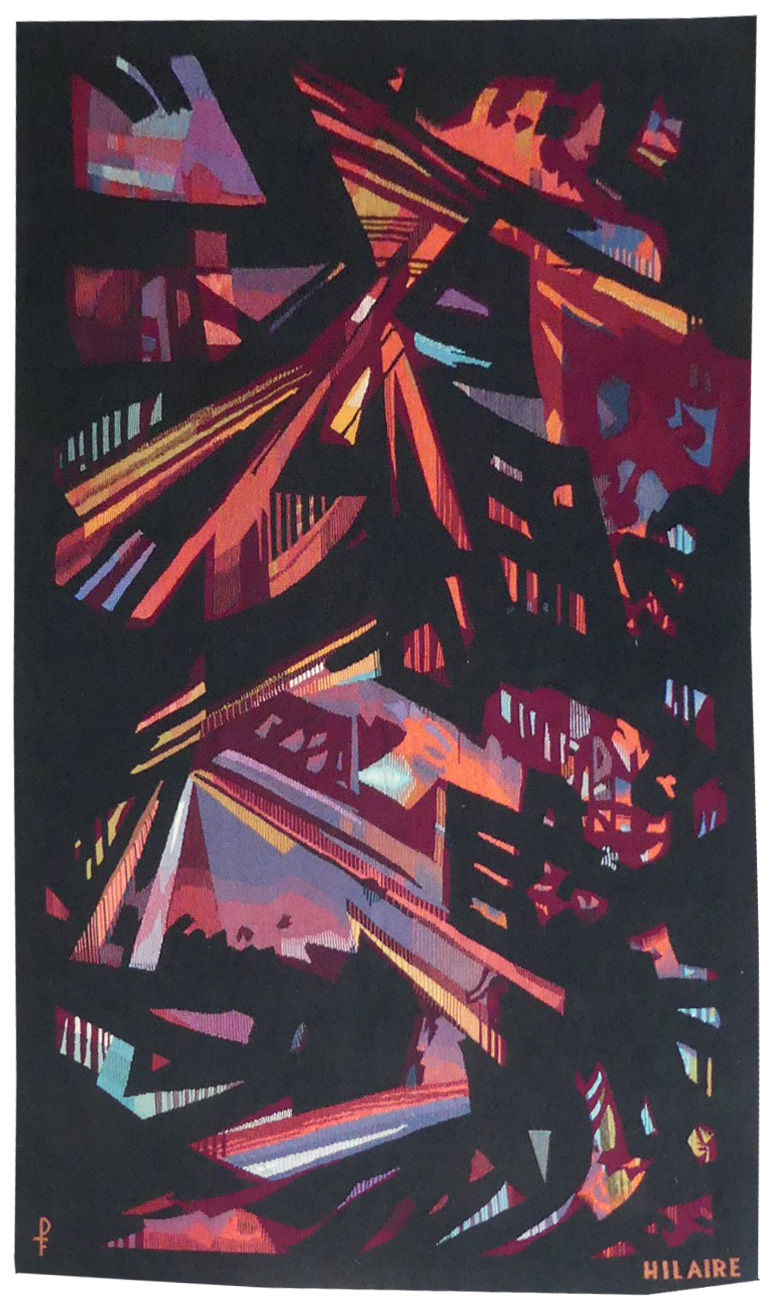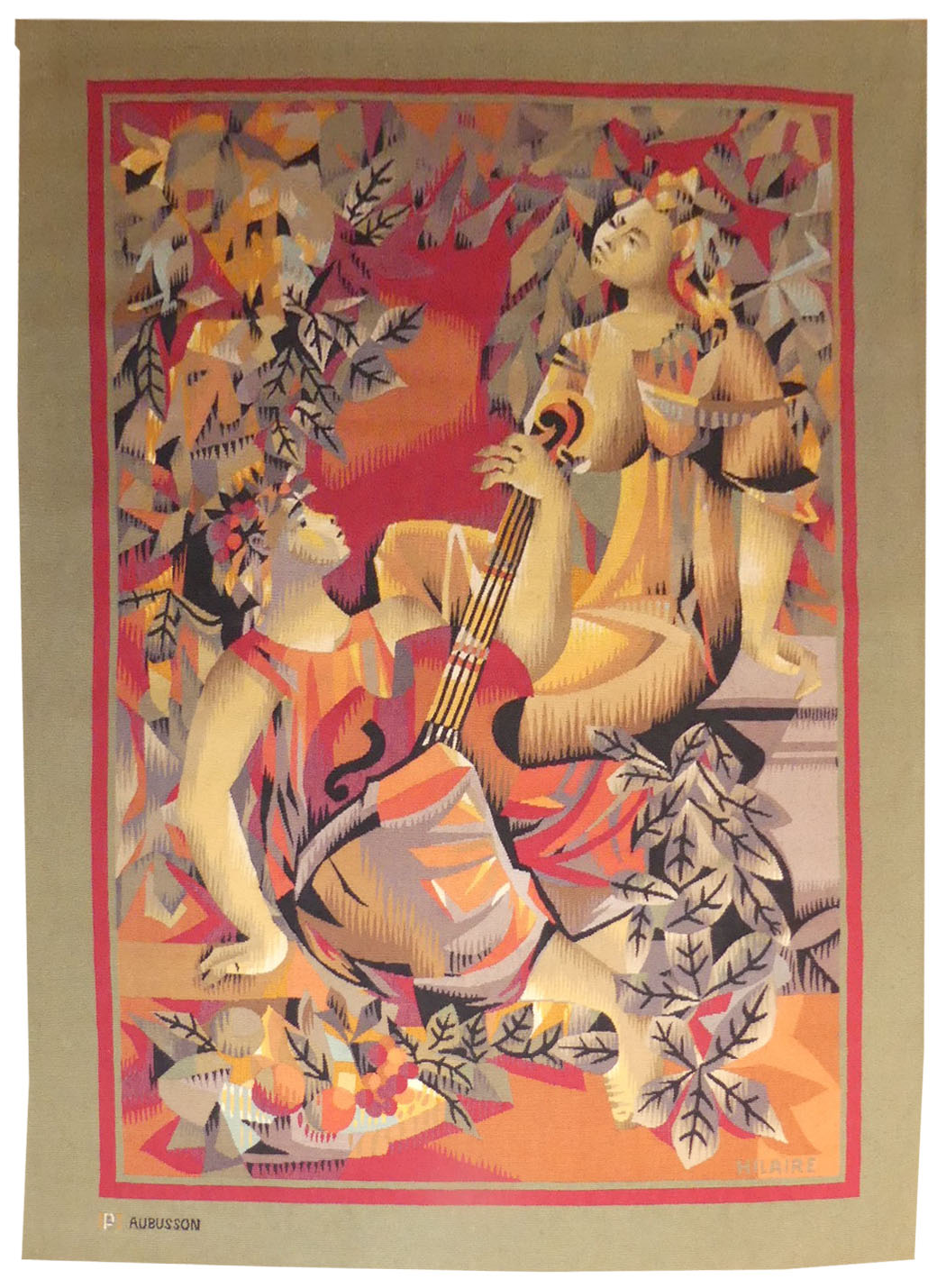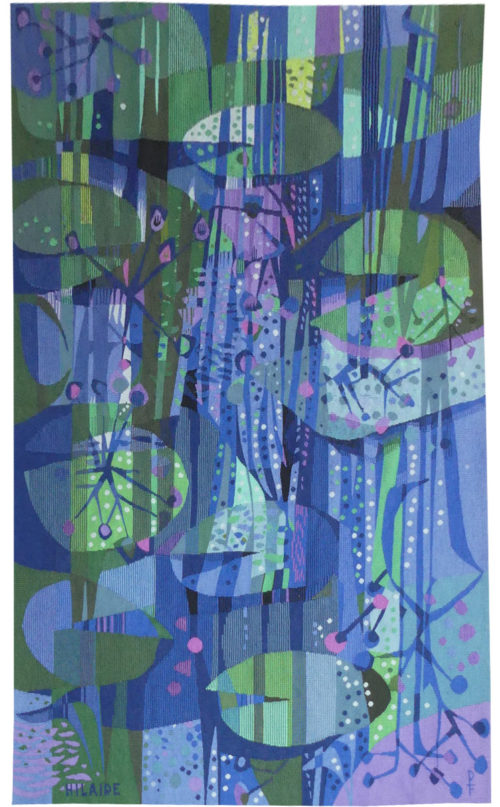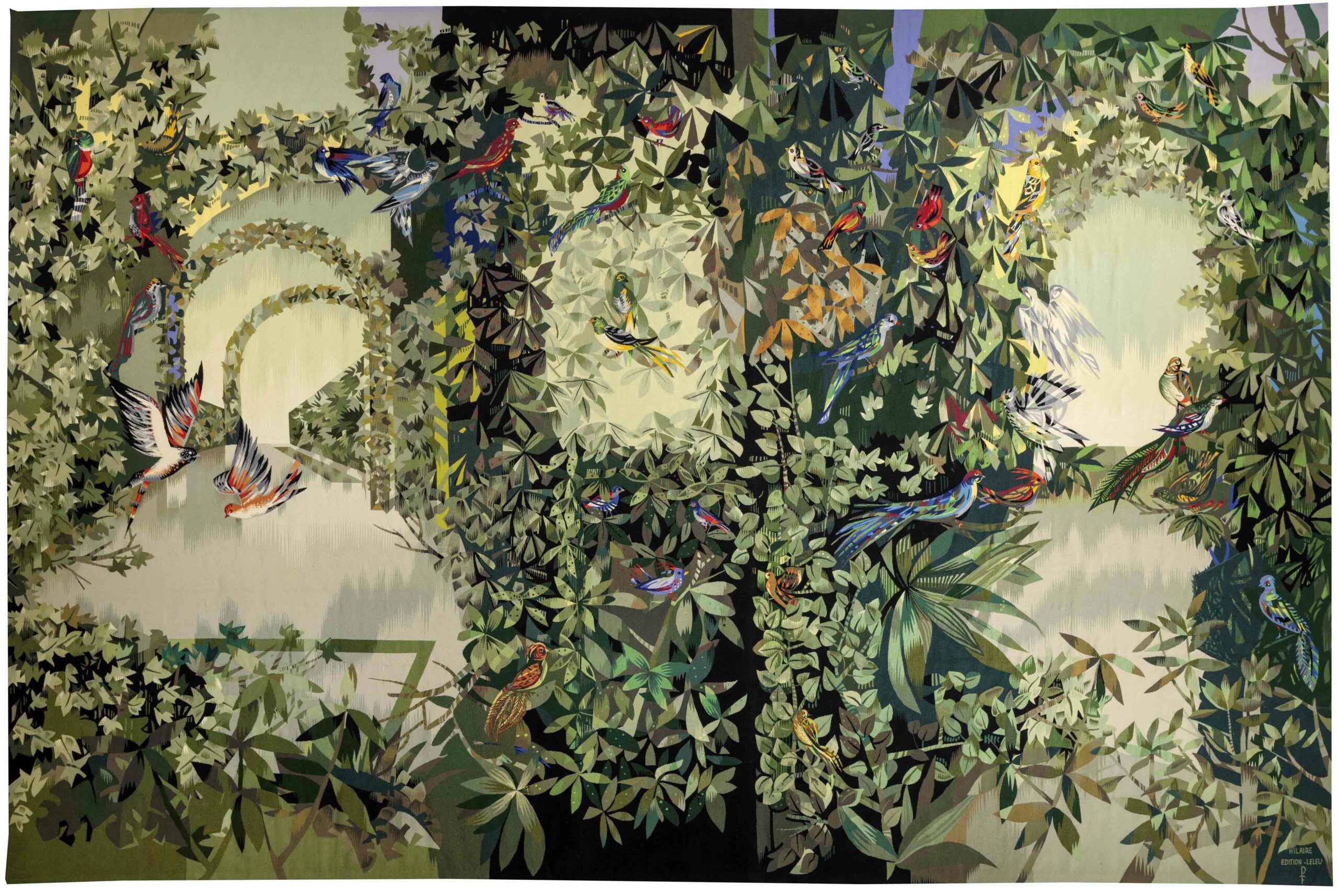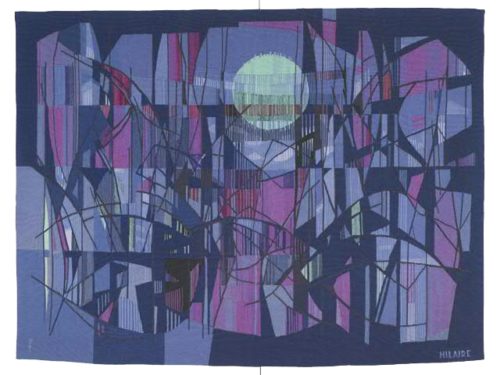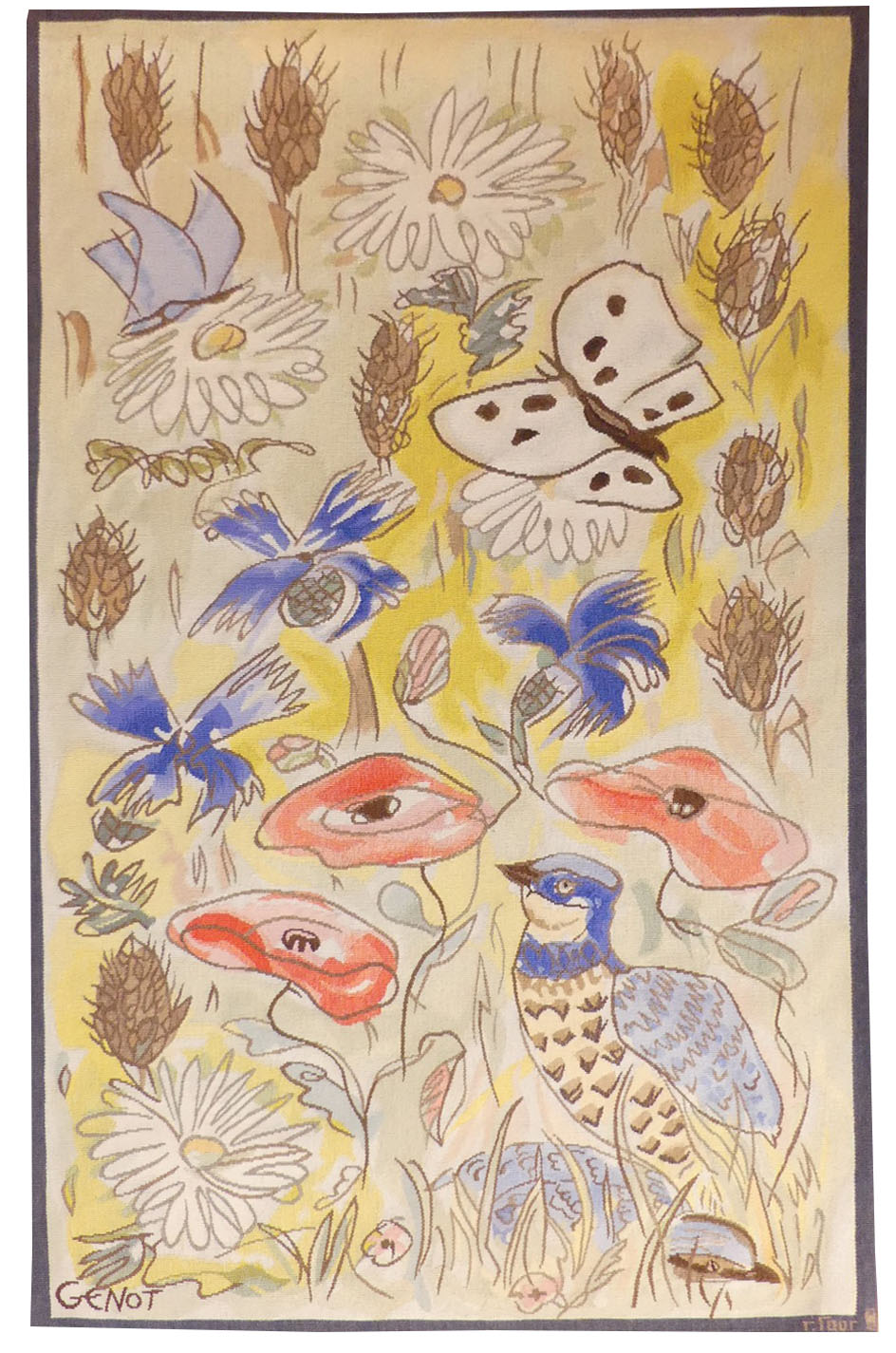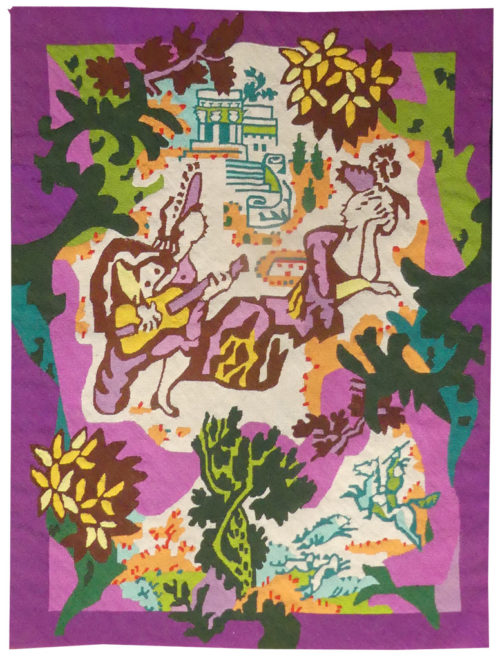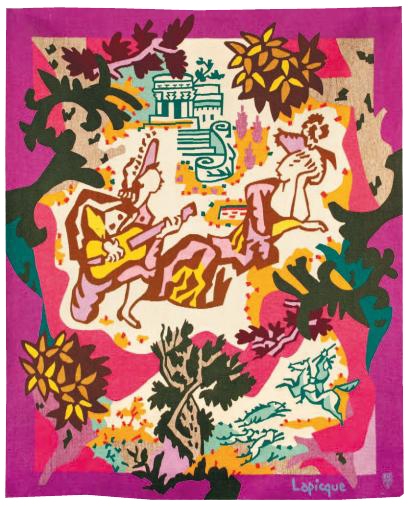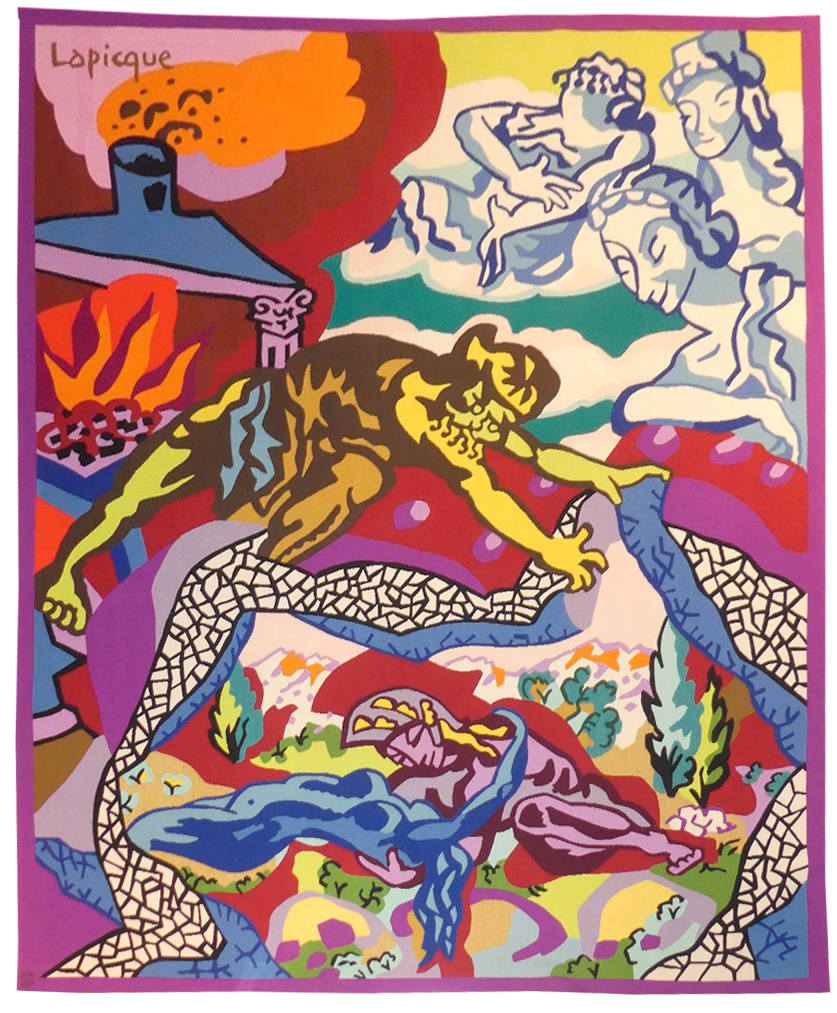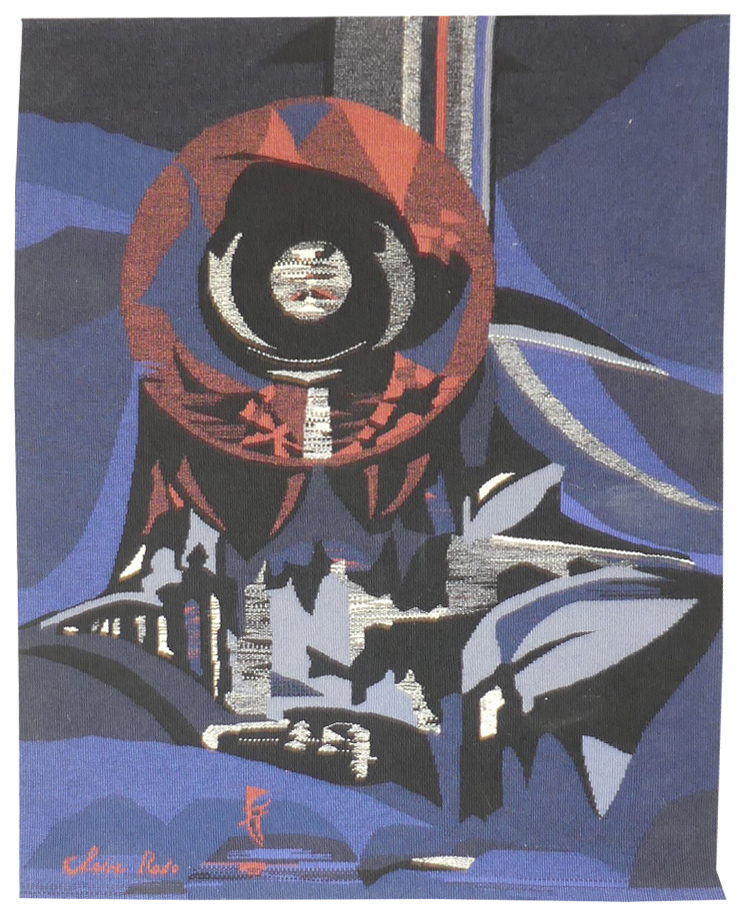-
Sérénade
Aubusson tapestry woven in the Pinton workshop. Circa 1950. With a taste for the large-scale, influenced by Untersteller at the Ecole des Beaux Arts, Hilaire undertook numerous mural paintings. In the same vein, beginning in 1949, along with a number of other artists stimulated by Lurçat, (he would join the latter at the A.P.C.T. Association des Peintres-Cartonniers de Tapisserie) he designed a number of cartoons some of which were woven at Beauvais or at Les Gobelins. This tapestry is probably one of Hilaire’s first cartoons for the medium, at a period in his work when the human figure was still omnipresent (before disappearing completely around 1960), and he was being regularly commissioned for works in public spaces : this bucolic « Serenade » can be seen to refer to « Quatuor » a cartoon dating from 1950 and woven by Pinton for the Mobilier National. Bibliography : Exhibition catalogue Hilaire, œuvre tissé, galerie Verrière, 1970 Exhibition catalogue, du trait à la lumière, Musée Départemental Georges de la Tour at Vic-sur-Seille, 2010. -
Aubusson tapestry woven in the Pinton workshop. With label, n°6/6. 1968.With a taste for the large-scale, influenced by Untersteller at the Ecole des Beaux Arts, Hilaire undertook numerous mural paintings. In the same vein, beginning in 1949, along with a number of other artists stimulated by Lurçat, (he would join the latter at the A.P.C.T. Association des Peintres-Cartonniers de Tapisserie) he designed a number of cartoons some of which were woven at Beauvais or at Les Gobelins. Hilaire makes the subject, previously referenced by Monet, his own in his habitual, cubist (and tending towards the abstract) style, characterised by lines and circular shapes in an exalted blue and green colour scheme. His early passion for horticulture, which was originally to be his profession, here echoes that of Monet in Giverny. Bibliography : Exhibition catalogue Hilaire, œuvre tissé, galerie Verrière, 1970, ill. Exhibition catalogue, du trait à la lumière, Musée Départemental Georges de la Tour at Vic-sur-Seille, 2010.
-
Treilles (trellis)
Aubusson tapestry woven in the Pinton workshop for Leleu. With label. 1964.With a taste for the large-scale, influenced by Untersteller at the Ecole des Beaux Arts, Hilaire undertook numerous mural paintings. In the same vein, beginning in 1949, along with a number of other artists stimulated by Lurçat, (he would join the latter at the A.P.C.T. Association des Peintres-Cartonniers de Tapisserie) he designed a number of cartoons some of which were woven at Beauvais or at Les Gobelins. This tapestry hung in the dining-room of the villa Médy Roc, at the Cap d’Antibes, for which the Leleu studio designed furnishings and fittings starting in 1957 : their philosophy, inspired by Jacques Adnet’s theories of the interweaving of architecture, furniture and tapestry design , which should all be unified by a single view, was to lean into the idea of a tradition of good taste “à la française”, as interpreted by the best designers and artists of the period. With this in mind, another work, also by Hilaire, “Jardin à la française” was already in place in the dining-room before this tapestry, where a traditional trellis shelters birds of more exotic plumage, was installed in the same area in 1964. Both works appear in the film “Les seins de glace”, directed by Lautner featuring Delon, Brasseur and Mireille Darc, which was filmed on location in the villa. Provenance : villa Médy Roc, Cap d’Antibes Bibliography : Exhibition catalogue Hilaire, œuvre tissé, galerie Verrière, 1970 Exhibition catalogue, du trait à la lumière, Musée Départemental Georges de la Tour at Vic-sur-Seille, 2010. -
Camargue
Aubusson tapestry woven in the Pinton workshop. Complete with certificate of origin signed by the artist n° 4 of 6. 1963. With a taste for the large-scale, influenced by Untersteller at the Ecole des Beaux Arts, Hilaire undertook numerous mural paintings. In the same vein, beginning in 1949, along with a number of other artists stimulated by Lurçat, (he would join the latter at the A.P.C.T. Association des Peintres-Cartonniers de Tapisserie) he designed a number of cartoons some of which were woven at Beauvais or at Les Gobelins. His figurative cubist-influenced style (which sometimes approaches abstraction) is immediately recognisable in his tapestry cartoons : in this one, but also for example in the one designed for the Salon Fontainebleau for the ocean liner France, “Sous-bois” (undergrowth) (190 x 988 cm, Pinton frères, reproduced in Le paquebot France, Armelle Bouchet Mazas, Paris 2006p. 169) where shapes and colours are fragmented in a kaleidoscopic fashion. “Camargue” is reproduced in the “Tapisserie d’Aubusson” sample collection of the Guéret Chamber of Commerce and Industry published in the early 1980’s to illstrate the technical competence of the Aubusson workshops. Bibliography : Exhibition catalogue Hilaire, œuvre tissé, galerie Verrière, 1970 (ill.) Exhibition catalogue, du trait à la lumière, Musée Départemental Georges de la Tour at Vic-sur-Seille, 2010. -
Les mauvaises herbes (Weeds)
A rare incursion into tapestry design by one better-known as a lover of books, an occasional illustrator, and a wine-grower.Aubusson tapestry woven by the Four workshop. With signed label, n°6/8. Circa 1980. -
Concert champêtre (Outdoor concert)
Needle-work tapestry. Circa 1965. « It is thus easy to understand that, having based my painting on my love of tapestry, it was relatively easy for me, and particularly tempting, to produce tapestries which were faithful to my painting” writes the artist in the exhibition catalogue for the 1970 show at the Galerie Verrière. It is not until 1961 that he started making designs (over 50) both for woven tapestries (at Aubusson, but also for the Mobilier National with, on occasion, the collaboration of Pierre Baudoin), but also those employing needlepoint. The artist’s very audacious palette is immediately recognisable in these cartons, with their use of primary colours or, as here, revolving around a very vivid pink with a rather dislocated storyline between the concert in the foreground and the hunting scene in the distance. Provenance : Elmina Auger collection Bibliography : Exhibition catalogue, Lapicque tapisseries, Paris, galerie Villand & Galanis, 1964-1965 Exhibition catalogue, Lapicque, Lyons, Galerie Verrière 1970 -
Concert champêtre (Outdoor concert)
Aubusson tapestry woven in the Picaud workshop for the Verriere Gallery of Lyons. Complete with its certificate signed by the artist ; n° 1 of 4. Circa 1970 « It is thus easy to understand that, having based my painting on my love of tapestry, it was relatively easy for me, and particularly tempting, to produce tapestries which were faithful to my painting” writes the artist in the exhibition catalogue for the 1970 show at the Galerie Verrière. It is not until 1961 that he started making designs (over 50) both for woven tapestries (at Aubusson, but also for the Mobilier National with, on occasion, the collaboration of Pierre Baudoin), but also those employing needlepoint. The artist’s very audacious palette is immediately recognisable in these cartons, with their use of primary colours or, as here, revolving around a very vivid pink with a rather dislocated storyline between the concert in the foreground and the hunting scene in the distance. Bibliography : Exhibition catalogue, Expo Lapicque, Lyons, Galerie Verrière 1970 -
Arès et Aphrodite (Ares and Aphrodite)
« It is thus easy to understand that, having based my painting on my love of tapestry, it was relatively easy for me, and particularly tempting, to produce tapestries which were faithful to my painting” writes the artist in the exhibition catalogue for the 1970 show at the Galerie Verrière.It is not until 1961 that he started making designs (over 50) both for woven tapestries (at Aubusson, but also for the Mobilier National with, on occasion, the collaboration of Pierre Baudoin), but also those employing needlepoint. The artist’s very audacious palette is immediately recognisable in these cartons, with their use of primary colours. But if Lapicque’s artistic language is established in the 1950’s, the themes which appear in his work evolve with time : thus mythological subjects (recurrent in the history of tapestry making) appear in his work following a journey to Greece in 1964, and « Diane et Actéon », then « Pélops » were the first of his cartoons to be woven in Aubusson predating “Arès et Aphrodite” whose depiction is faithful to the ancient texts (Homer, Ovid) : Hephaestus throwing his net and the Olympian gods laughing at the scene.... Bibliography : Exhibition catalogue, Expo Lapicque, Lyons, Galerie Verrière 1970Aubusson tapestry woven in the Picaud workshop. With signed label, n°1/4. Circa 1970. -
La nuit (the night)
In 1964 Claire Rado designed and wove in her workshop in Suresnes, her very first tapestry which she then exhibited at the Galerie La Demeure. She weaves her own cartoons, but, rather like Daquin or Coffinet for example, also produces the work of others (Soulages notably as far as Rado is concerned). Her first abstract works were followed by monumental woven figures around which she left the warp bare. A tapestry dating from the artist’s early work, where the subject is chosen and dealt with to contribute to her technical skills.Tapestry woven by Claire Rado's workshop. With signed label. Circa 1965.


